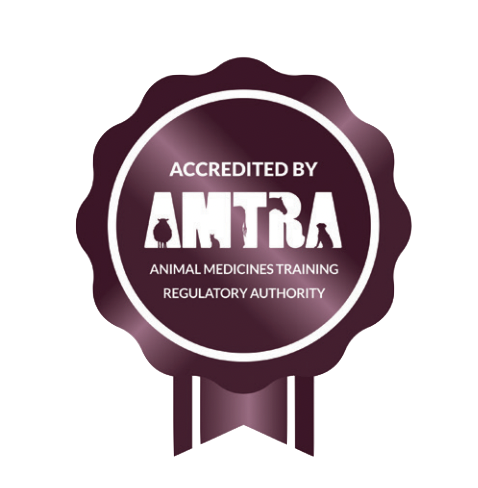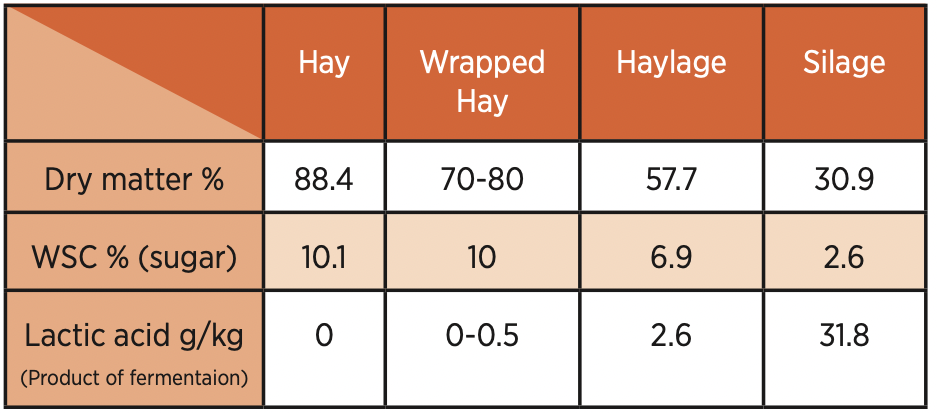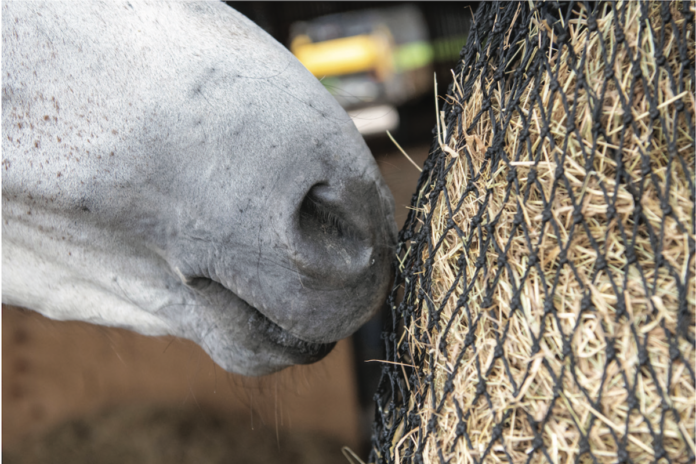THE IMPORTANCE OF FORAGES FOR REDUCING THE RISK OF EGUS – WHAT’S THE LATEST ADVICE?

By Katie Williams M.Sc. (Dist) R Nutr, Technical Manager at Dengie Horse Feeds
AMTRA is required by the Veterinary Medicines Regulations to ensure its RAMAs/SQPs undertake CPD. All RAMAs/SQPs must earn a certain number of CPD points in a given period of time in order to retain their qualification. RAMAs/SQPs who read this feature and submit correct answers to the questions below will receive two CPD points. For more about AMTRA and becoming a RAMA/SQP, visit www.amtra.org.uk
Over the last decade, studies have increased our awareness and understanding of Equine Gastric Ulcer Syndrome but there is still much to learn. We know there are two distinct diseases which affect different areas of the stomach: Equine Squamous Gastric Disease (ESGD) and Equine Glandular Gastric Disease (EGGD). Whilst a recognised aetiology and recommended management regimes exist for ESGD, less is known about EGGD.
SYMPTOMS OF GASTRIC ULCERS IN HORSES
Symptoms are not always very easy to distinguish from other issues or diseases but some common ones include weight loss, dull coat, biting when being girthed and intermittent colic. However, it is important to consider that good doers and those that look healthy on the outside can have ulcers too. It is also apparent that there is no link between the severity of ulcers and the symptoms – some horses are clearly very stoic and can have grade 4 ulcers with no obvious clinical signs.
There are some practices that are known to increase the risk of horses having ulcers:
- Feeding too little fibre – chewing fibre produces more than double the amount of saliva than chewing concentrates.
- Feeding 1% of bodyweight as grain resulted in a marked increase in ulcers in non-exercised horses.
- Feeding 2g/kg BW starch per day or 1g/kg BW per meal more than doubled the risk of a horse having ulcers.
SO IF TOO LITTLE FORAGE IS A RISK FACTOR, HOW MUCH FORAGE SHOULD I FEED?
Ad lib forage is the simple answer assuming the horse isn’t overweight. Horses will typically consume between 2 and 2.5% of bodyweight per day as forage when offered ad lib access. Ponies may consume more so it is important to watch for weight gain as a result.
In fact, the challenge of feeding enough forage to reduce the risk of ulcers without promoting weight gain was a key issue for many of the 650 horse owners that participated in a survey about managing good doers in 2021. Around 20% of horse owners mentioned they can’t limit access to pasture and a third of respondents said they didn’t want to stable for longer. The use of muzzles was also not an option for about a third of horse owners too, either because they didn’t like the idea of using one or they felt it wasn’t safe to do so with their horse or pony.
Clearly in many cases we do have to limit our horses’ access to grass to manage their weight and so what do we replace it with to find that balance between reducing ulcer risk but maintaining digestive health? Grass hay or haylage can still be too much for some good doers especially if fed ad lib and so restricting the amount fed is often necessary.
Achieving consensus and a clear directive on the minimal dry matter intake for maintaining optimal digestive health has been confused by different studies which can be open to interpretation and differ in the timeframe the advice is recommended for.
The work of Dugdale et al (2010) is regularly cited as they restricted intake to 1% of bodyweight dry matter which achieved significant weight loss without adverse effects on the welfare of the horse. However, the criteria used to measure welfare in this study related to behaviour and the time that ponies spent in three major behavioural categories (eating, resting and play). There is no reference in this study to the incidence of gastric ulcers and the study lasted 12 weeks which is a relatively short timeframe.
The increasing frequency with which ulcers are being diagnosed may account for why the recommendations for minimal dry matter intake tend to increase in more recent studies. Morgan et al (2016) state they initially recommended 1.5% of bodyweight in fresh weight of hay but adjusted if necessary, depending on response and Rendle et al (2020) cite 1.5% dry matter which is the level most equine nutritionists would work to for the long-term management of good doers. The veterinary perspective in some cases may be
to restrict intake to below 1.5% in the acute scenario to deal with significant obesity, hyperinsulinaemia and acute laminitis but this is often getting lost in interpretation and communication.
There are other potential issues aside from EGUS to consider too. It has been shown in trials in mice for example, that a low fibre diet increases the permeability of the gut – a phenomenon known as leaky-gut syndrome. When fibre is fermented in the hind gut, one of the volatile fatty acids produced is butyrate and this is the energy used by the colonocytes (gut cells) themselves. Insufficient fibre and therefore butyrate, can compromise the health of the cells creating bigger gaps between them which allows contents of the gut that shouldn’t pass through, to do so. Therefore, the better strategy for feeding to maintain gut health without promoting excessive weight gain is to feed a lower calorie forage so that more can be fed.
CAN STRAW BE FED TO HORSES WITH ULCERS?
Back in 2009, a study that looked at the incidence of gastric ulceration in a population of horses found that those that were fed straw as the sole or predominant fibre source were more likely to have ulcers. The reasons given related to the structure of straw and the fact that straw contains low levels of calcium and protein. This makes sense given that it is alfalfa’s naturally high protein and calcium levels that are thought to make it a superior buffer.
However, the key here is that straw was used as the sole or predominant fibre source which is not typically done in the UK. Recognising that straw can be useful as a low-calorie forage source for good doers, a follow up study has been published investigating the safety of feeding 50% wheat straw to replace haylage. The study by Jansson et al (2021) found no ill effects and specifically looked for gastric ulcers. Some simple calculations show that if straw replaces 1/3 of the weight of an average hay, a reduction in energy intake of 16% is achieved. Obviously replacing half the haylage ration will achieve an even greater reduction.
FORAGES FOR THOSE THAT AREN’T GOOD DOERS
The more stereotypical horse with ulcers is one that doesn’t hold weight and looks in poor condition. In these scenarios the challenge is promoting weight gain without increasing starch intake. The first step to achieving this is to use as digestible a form of forage as possible and feed plenty of it.
CAN I USE HAYLAGE FOR A HORSE WITH ULCERS?

The concern about using a true haylage for horses with ulcers is that the fermentation process used to conserve the forage produces acids. It is logical not to feed a forage that has increased levels of acidity to a horse with an issue related to increased exposure to acid.
However, a more accurate description of many so-called haylages would be wrapped hay as they are often very dry which has meant that little or no fermentation has occurred. This means the levels of acidity are no different to a normal hay which can be seen in table 1. A possible benefit of using wrapped hay is that it may well have been harvested earlier and so is likely to be more digestible meaning that the horse will do better on it.
Forages containing more moisture and cut earlier are often softer and so may be easier for horses with ulcers to manage and are often more palatable which is useful for poorer doers who may not have a big appetite. For poor doers, feeding forage ad lib is ideal as there is no reason to restrict them.
SHOULD MY ULCER PRONE HORSE HAVE A BUCKET FEED?
Whilst the significant majority of any horse’s diet should be forage, even good do-ers can benefit from a bucket feed to provide a balanced diet. UK pastures lack a number of key trace minerals including zinc, copper and selenium and these nutrients are important for many different functions such as energy breakdown and utilisation and as part of the body’s antioxidant defence system. Topping up these nutrients by adding a broad-spectrum vitamin and mineral supplement or balancer to a low calorie chopped fibre feed to act as a carrier helps to ensure a balanced diet is supplied.
Feeding a double handful of a chopped fibre feed in the 20-25 minutes before exercising is also recommended to help prevent ‘acid splash’ in the non-glandular region of the horse’s stomach. The fibre ensures the stomach isn’t empty and suppresses the movement of the acidic contents when the horse moves.
For poorer doers and those in harder levels of work, forage may not be sufficient to keep them in an acceptable condition and so the bucket feed is an important part of the ration. There are a range of feeds with the BETA approval mark for horses and ponies prone to EGUS which range in ingredients and type. Many contain alfalfa to a lesser or greater extent but its suitability for those prone to ulcers has caused some confusion.
CAN I USE ALFALFA FOR HORSES WITH ULCERS?
The simple answer is yes you can. Studies back in the early 2000s (Nadeua et al, 2000; Lybbert et al, 2007) showed that alfalfa was more beneficial for horses with ulcers (ESGD) compared to grass forages, as the high levels of calcium and magnesium it contains act as natural buffers to acidity.
WHY DOES ALFALFA CONTAIN MORE CALCIUM THAN GRASS FORAGES?
Alfalfa has really deep roots – about 3 to 4 metres – and the calcium at this depth in the soil is more available for absorption. This means that alfalfa plants can take up more calcium than grass – chopped alfalfa contains between 30 and 50% more calcium than grass forages. Early studies suggest that omeprazole is reducing calcium absorption in the horse as is seen in humans and in Swanhall et al’s (2018) study, they recommend using bio-available calcium sources in the diet to help counteract this effect. Plant based sources of calcium such as alfalfa are much easier for the horse to absorb than inorganic sources such as limestone flour.
HOW MUCH ALFALFA SHOULD BE FED?
Researchers suggest adding around 200grams, which is about half a Stubbs scoop, when cereals are fed to help counteract the increases in acidity generated by the starch. In many cases, high quality fibre sources can be used to provide the horse with sufficient energy for the work they are doing reducing the need to feed cereals and thereby reducing starch intake. In these situations, the feeding rates would be higher than 200grams so it really depends on whether the alfalfa is being used as the main energy source or alongside other feeds.
WHY IS ALFALFA SO LOW IN STARCH?
Like other plants, alfalfa makes sugar when photosynthesising but it stores any surplus sugar as starch in its roots – the part that horses don’t eat! Grass plants tend to store sugar as fructan in leaves and the stem which is why they supply the horse with more sugar.
SO WHY ARE SOME PEOPLE CONCERNED ABOUT FEEDING ALFALFA?
Some people look at the percentage of protein in a pure alfalfa feed and are put off as they don’t consider how much is being fed and therefore the actual amount of protein the horse is consuming. For example, one large Stubbs scoop of a pure alfalfa feed containing between 12 and 14% crude protein supplies 48 grams of protein which is about 6-8% of a 500kgs horse’s daily maintenance needs.
There has also been a study published that has caused confusion about the use of alfalfa. It explored the incidence of ulcers in foals and used the weaning process to induce ulcers. The researchers then compared groups fed alfalfa chaff or alfalfa pellets or hay. Foals were fed 3kgs (7.5 Stubbs scoops) of alfalfa chaff (way more than is typically used or what would typically be recommended for foals), 2.7kgs of oats and 0.25kgs of soybean meal. It’s also important to note that the alfalfa chaff used was 40% lower in calcium than the alfalfa pellets used.
Foals fed the alfalfa chaff had higher ulcer scores at the pylorus than those fed alfalfa pellets or hay but none showed any clinical signs. The same research group have recently published another study comparing grass and alfalfa hay in adult horses. The horse with ulcers at the start of the study no longer had ulcers after being fed the alfalfa hay.
SO WHAT CAN WE CONCLUDE?
- There have been no negative effects in the squamous region of the stomach in horses of any age from feeding alfalfa.
- The only group where an effect with alfalfa chaff has been seen is weaned foals but it was fed at much higher levels than is typically done – there were no issues associated with feeding alfalfa pellets which would still provide some natural buffering from the calcium they contain.
- Alfalfa chaff or chop is generally considered beneficial for adult horses at risk of or prone to EGUS due to its natural buffering potential.
- References
- Dugdale et al (2010) Effect of dietary restriction on body condition, composition and welfare of overweight and obese pony mares. Equine Veterinary Journal, 42 (7) 600-610.
- Jansson et al (2021) Straw as an Alternative to Grass Forage in Horses—Effects on Post-Prandial Metabolic Profile, Energy Intake, Behaviour and Gastric Ulceration. Animals. 11.
- Lybbert, T. et al (2007), Proceedings of Annual Convention of the AAEP, Orlando, Florida, 2007.
- Morgan et al (2016) Treatment of Equine Metabolic Syndrome: A clinical case series. Equine Veterinary Journal. 48. 422-426.
- Nadeau, J. et al (2000) Evaluation of diet as a cause of gastric ulcers in horses. American Journal of Veterinary Research. Jul;61(7):784-90.
- Rendle et al (2020) Tackling obesity and related laminitis in equine patients. Veterinary Times Equine, 6 (1) 6-9.
- Swanhall et al (2018) Mineral and Vitamin Supplementation Including Marine Derived Calcium Increases Bone Density in Thoroughbreds. Proceedings of the Australasian Equine Science Symposium

ABOUT ETN’S RAMA/SQP FEATURES
ETN’s series of CPD features helps RAMAs (Registered Animal Medicines Advisors/SQPs) earn the CPD (continuing professional development) points they need. The features are accredited by AMTRA, and highlight some of the most important subject areas for RAMAs/ SQPs specialising in equine and companion animal medicine.
AMTRA is required by the Veterinary Medicines Regulations to ensure its RAMAs/SQPs undertake CPD. All RAMAs/SQPs must earn a certain number of CPD points in a given period of time in order to retain their qualification. RAMAs/SQPs who read this feature and submit correct answers to the questions below will receive two CPD points. For more about AMTRA and becoming a RAMA/SQP, visit www.amtra.org.uk











